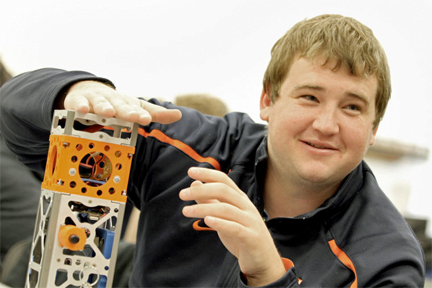
Steven Harrington works with the JefferSat cubesat, a small satellite that will measure cosmic ray activity high in the atmosphere.
Photo by Ryan M. Kelly of The Daily Progress.
If all goes as planned, one of the balloons will be attached to a satellite designed by students at a unique class at the University of Virginia (UVa). For the past two years, the Spacecraft Design course at UVa, led by associate professor Christopher P. Goyne, has been working on just one project—a satellite he hopes to eventually launch into space. Goyne, who’s always looking for ways to help his students get practical experience, was also hoping for some outlet to test his project.
NASA provided a chance to do both. The agency has been reaching out to college space programs, offering the chance to fly student experiments to the edge of space using high-altitude balloons.
“Doing a balloon flight is sort of a stepping stone to space flight,” Goyne said.
Ultimately, Goyne is hoping to build a satellite that uses a smartphone as the flight computer. He said he wanted to use a device that most students are familiar with, and show how relatively cheap everyday objects can be used in unusual ways.
“Smartphones have more processing power than early satellites,” Goyne said. “Smartphones are a technology everybody knows … it just seemed like a natural progression.”
Next year’s exercise is part of NASA’s effort to learn more about cosmic radiation, a form of radiation people are exposed to whenever they fly at high altitudes. Goyne’s students are putting together a modified version of their own satellite for the NASA flight, one that has the equipment to detect the amount of radiation at that altitude. Goyne said a typical commercial flight exposes passengers to the same amount of radiation they’d be exposed to getting a chest X-ray. That’s not a dangerous amount for most people, he said, but scientists are worried about the effect on flight crews and astronauts. Levels of cosmic radiation change day-to-day and can be influenced by certain events, such as solar storms. NASA is eventually hoping to find ways to predict cosmic radiation levels, allowing pilots to fly around certain hotspots.
“It’s just like avoiding a bad storm,” said Christina Gilligan, one of 30 students in Goyne’s class. Gilligan is overseeing the team in charge of putting radiation detection equipment on the satellite.
Bryan Dale, an aerospace engineering major in the class, said the students will have to meet NASA’s rigorous standards and deadlines. But it’s worth it for Dale, who said he’s thrilled at the prospect of designing something that could be used by NASA. “It’s something I never thought I’d be involved in, especially at the undergraduate level,” he said. (Source: The Daily Progress, Charlottesville, Virginia, posted by Derek Quizon)

